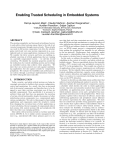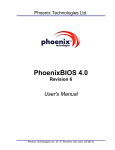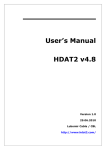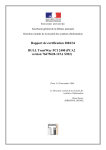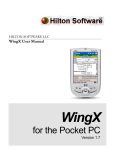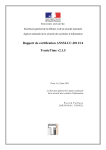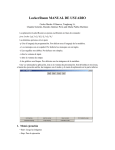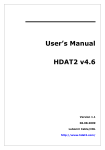Download FullText - IJJ: The Research Bulletin of JORDAN ACM
Transcript
The
Research
Bulletin
of
Jordan
ACM,
Volume
II
(II)
P a g e | 70
A FRAMEWORK FOR EMBEDDED MALWARE CONSIDERATIONS:
EMBEDDED SYSTEMS VULNERABILITIES TO INJECTION OF MALWARE IN A
FIRMWARE UNDER ATTACK
HAIDAR ALSALEH, SUFIAN YOUSEF and OMAR ARABEYYAT
ANGLIA RUSKIN UNIVERSITY, UK
ABSTRACT
With the emergence and proliferation of new methods for
implanting malware, the next frontiers in system
vulnerabilities are the embedded viruses or system attacks
through vulnerabilities below the application layer. This paper
researches contemporary and potential attacks that implant
malware functions underneath the operating system (OS)
within the firmware. At the lower OSI layers, the Malware
take control and command before starting the operating
system. The common wisdom is that if the underlying
firmware cannot be trusted, then the OS and the applications
depended on the firmware also cannot be trusted.
This paper presents a comprehensive research on malwares in
the BIOS and firmware and discusses and analyse them with
specific interest towards the SMM. Furthermore this paper
provides a novel and general solution approach to common
firmware and for a secure processing framework.
This paper showed in a novel approach that if the firmware
cannot be trusted then the OS and the software that are
dependent on the underlying firmware might not be trusted.
Index Terms – Embedded Security, SMM,
BIOS, Trusted Hardware, Root Kit.
1. Introduction
The most lethal form of embedded malware comes in the
form of a rootkit attack. The first widely known instance of
wide spread exploitation was in 2005. Within that incident the
rootkit was devoid of known malicious intention when Sony
Corporation of Japan implanted this modus operandi so as to
hide its Intellectual Protection (IP) copy protection software
(Michael 2010). The implementations involved the inclusion
of eXtended Copy Protection (XCP) and MediaMax CD-3
software on Sony brand music CDs. This software silently
and automatically installed on the Windows OS hosting the
playing CDs, causing alteration of the operating system. To
obfuscate itself, the Sony rootkit used and hid files, registry
keys and processes that starts with the string name of $sys$.
This obfuscation opened the door for malicious exploitation
by others.
It is acknowledged that the less common systems such as
Apple and Linux do face fewer attacks, as compared to
Microsoft products. Also custom made and special
applications as well as embedded processors are rarely
attacked unless the attack is targeted (Chen 2010). This is not
an indication of the sturdiness of the Apple or Linux design
but is the result of the wide spread use of the MS System,
making the later more readily available for an exploitation.
Furthermore, unless the attack is targeted, attackers seek the
most “Bang for the Buck” effect, which would require system
types with wider platform proliferations such as usage across
differing intellectual, social and economic system and
applications.
There are other papers that researched the topic but were
hardware specific. While other papers targeted the firmware
but fell short of comprehensive analysis and lack effective
recommendations for a secure platform.
Malware detection is based on Cohen theorem. Cohen (1986)
built on the work of Goedel's, where Cohen implemented the
"proof by contradiction" technique to show that no perfect
virus checker can ever exist. However Cohen theorem is based
on the anti-malware tools that are hosted on the operating
system which are inert to malwares in the firmware, (this
research uniquely present to show that it is highly effective
method of an attack). Seshadri et al (2004) published their first
work on Software-based attestation for embedded devices.
Seshadri (2005) followed it by verifying integrity on legacy
platforms. Their two papers presented a note worthy issues,
however these papers and others failed to cover the SMM and
the Hypervisor Virtual Machine VM malware concerns.
The VM vulnerabilities were discussed by King et al (2006)
were the team showed that malware attack on the VM based
Rootkit (VMBR) was possible. Building on previous work,
Duflot et al (Duflot) worked on the privilege escalation issue
by manipulating the SMM code. Duflot results were the bases
for Embleton et al (2008) who to some extent discussed the
SMM (System Management Mode) rootkit as an entry into the
firmware.
This is a problematic topic to disquisition. Castelluccia et al
(2009a) presented their work on the difficulty of softwarebased attestation for embedded devices asserting the
difficulties associated with their research and presented their
recommendation only to see in less than a year be refuted by
Perrig (2010) of CyLab and Doorn of AMD. However it did
not take long for Perrig paper itself to be re-refuted by
Francillon (2010), and continue to confirm the difficulty of the
subject by Castelluccia (2009b).
Early research by King (2006) showed that malware attack
using methods implemented in the Virtual Machine based
Rootkit (VMBR) was possible. However their research was
based on simulation and their findings were narrow in its
applications and limited to specific hardware. Loic Duflot
(Duflot) followed King in showing that privileged mode
The
Research
Bulletin
of
Jordan
ACM,
escalation by manipulating the SMM code was possible and
can result in malware code injection to switch the system
operation mode to a higher user privilege level.
Emleton (2008) analysed the SMM threat as it relates to the
invocation of SMM in a rootkit however their work was not
fully published.
This paper introduction is shown in section 1, the SMM
Threats are presented in section 2, the SMM Mode Operations
are explained in section 3, the Embedded Rootkit Analyses is
shown in section 4. The full analysis of Firmware attacks is
supplied in section 5 and the Firmware vulnerabilities in the
BIOS32 are discussed in section 6. The simulation of the
attack on the Firmware is given in section 7 and the paper is
concluded in section 8.
2. SMM (System Management Mode)
Threats
Most common computing platforms (including PDAs and
IPhones, etc) share similar logical booting sequence. This
booting sequence involves three distinctive stages with
similar sequential order starting with System firmware
execution; then pointing and starting the Operating system
loader and finally loading the operating system (OS) from a
memory location. Although this paper discusses the BIOS in
the PC, it is equally viable to all other computing platforms
including consumer goods.
The system firmware is the lowest common denominator and
is the closest to the metal (hardware); this is sometimes
referred to as bare-metal coding. In the PC world the system
firmware would be hosted in the BIOS. In non-PC devices
this would also be the BIOS, however the BIOS may not be a
separate but Embedded Software hosted on a ROM or RAM
hardware device, and is co-hosted with the system application
software.
At stage one the system start with the Pre POST routine. This
routine commences by initialising the hardware relevant to the
system operations including the hardware initialisation of the
hosting CPU then the RAM. After the RAM is initialised and
the system firmware is copied, the Pre POST routine allocate
and initialise tables allocated in the main system memory
creating a 640k RAM segment, starting form space pointer 00
000 to A0 000. After the completion of Stage one, the System
firmware goes into protected mode and passes control to
Stage two.
To optimise memory each of the BIOS modules (except
Bootblock; BootCode, and the Decompression routine;
DECOMPCODE) are compressed using LZH compression
methods and containing an 8-bit checksum. The
decompression routine decompresses modules prior to
execution and places the uncompressed mode into CPU
RAM.
The SIMM code (in the firmware or BIOS) includes the
instructions for connecting peripheral components and
peripheral emulation to be available to the operating system
upon physical interconnection.
Volume
II
(II)
P a g e | 71
The System Management Mode (SMM) is invoked by the
execution of the SMM code (SMI handler) this is done during
high-privilege mode. This mode is part of the firmware boot
up cycle, and is invoked during the Power On Self Test
(POST) stage in BIOS.
There are two main functional areas for firmware codes; the
first is to initiate the boot up process, while the second is used
for run time mode. The later is where the booting code copies
the SMI handlers (interrupt code part of the SMM) for use
during run time and in parallel with full OS operation.
3. SMM Mode Operations
There are two methods for entering the SMM normal-mode
operations:
•
SMI interrupt, Hardware assertion (SMI pin), nonmaskable interrupts highest priority in the system.
•
SMINT instruction; Software assertion entry
through CPU instruction code (0F 38).
SMM is totally transparent to all application software on the
host, including the protected-mode operating system.
The most common method for invoking the SMM mode is by
the execution of the SMM code (SMI handler) in highprivilege mode during the firmware boot up cycle, as in the
Power on Self Test (POST) stage in BIOS. Once the SMM is
invoked it would be locked and placed into protected mode.
To penetrate the SMM mode while it is protected, the malware
must slither into the SMM while it is in open state or while the
SMM mode is in the state of a running normal-mode operation
which can be achieved either through SMI interrupt or through
SMINT command instruction:
•
SMI interrupt; Hardware physical assertion of the
allocated pin in the hardware casing. This is
intended to invoke the interrupt mode. This would
lead to a non-maskable interrupts, which is the
highest priority in the system. The non-maskable
interrupt is a hardware event of high priority that
must get the immediate attention of the CPU. In
contrast maskable interrupt, would cause the CPU to
continue computing instructions processing until it
has time for a safe point for the CPU to take care of
this interrupt.
•
SMINT instruction; Software assertion that require
code instructions invoked upon the CPU to trigger
entry to the SMM through CPU instruction code (0F
38). Part of the SMM module within the firmware or
the BIOS is the SIMM code which is a firmware
code that includes the instructions for connecting
peripheral components and serve as peripheral
emulation needed to be available for the operating
system while it is independent of the OS or the
hosting system.
The SMM for the Intel IA-32 model design supports three
operating modes and one quasi-operating mode. These four
modes are listed below:
The
•
•
•
Research
Bulletin
of
Jordan
ACM,
Virtual-8086 mode — if the processor placed into
protected mode, then it would support a quasioperational mode known as virtual-8086. This mode
is for executing 8086 software in a protected,
multitasking environment.
Real-address mode — In this mode the SMM
operate in real time mode providing real time code
execution services for software code capable of
running on an Intel 8086 processor. While in this
mode the SMM has the capability to switch to other
modes. Protected mode — (32 or 64 bit operating
system) Native operating mode with a set of
architectural features and backward compatibility
for the existing legacy software base.
System management mode (SMM) — SMM first
launched with the Intel386 SL processor however it
became standard architectural feature for all
subsequent IA-32 processors. The main function is
to provide transparent mechanism for implementing
power management and OEM compatibilities
functionality.
The SMM operation is a separate operating mode of the CPU,
with distinct hardware and software dependency intended for
use only by system firmware and not by application software
or general-purpose system software.. The operating system is
not aware of the SMM or the SMI mode. One exception to the
SMI is that it can be invoked by the system. When the system
invoke this mode, the CPU would function separately from
Real, Virtual, or Protected modes, however it allows system
designers to add components that operate transparently to the
operating system and software applications (Advanced Micro
Devices Inc, 1997).
During the SMI mode, all normal instruction; component
initialisation; and operating system execution are suspended
by the CPU however the CPU return system hardware and
software control to the operating system upon completing the
SMM mode, see Diagram 1, the Flow chart of SMM Routine.
Volume
II
(II)
P a g e | 72
below, see Code 1 Auto Halt Restart Implementation PseudoCode:
Begin
; The Auto Halt Restart slot at register-offset 7F02h in
SMRAM indicates
; To the SMM handler that the SMI interrupted the CPU
during a HALT
; State Bit position 0 of 7F02h will be set to a one in this
condition
{
if EFLAGS.21 is write able then ; should be done during
ID process
{
if HLT instruction needs to be
restarted then
{
if SMI during halt state then
;bit 0 of offset
7F02h = 1
set HLT restart slot to 00FFh
;offset 7F00h
in state save map
}
}
else
SMM features are not supported
}
end
Code 1 Auto Halt Restart Implementation
Pseudo-Code
(Advanced Micro Devices Inc, 1995, P 22)
Once the SMM code is initiated the system transfer control to
the System Management Interrupt (SMI) in BIOS this is the
POST stage and prior to booting the operating system. Access
to the allocated memory is locked and secured from
modification or override by the BIOS by setting the D_LCK
bit to 1, memory can only be accessed if D_LCK is set to 0.
This locked state is not accessible even by the Operating
System. However it should be noted that if the malware code
is executed before reaching the POST and prior to the setting
of the D_LCK bit, then the SMI is accessible and vulnerable
to altercation.
Upon entering the SMM the CPU clears the “IF” flag to
disable INTR interrupts masks INTR, NMI, SMI, INIT, and
A20M interrupts. However INTR can be enabled within SMM
when the SMM handler set the IF flag to 1. A20M is disabled
so that address bit 20 is never masked when in SMM mode
(Advanced Micro Devices Inc, 2011). There are six steps to
this process, see Diagram 2.
Diagram 1 Flow chart of SMM Routine
(Cyrix inc, 1998, P 6)
An example of an interrupt code implementations
that halt processing and store registers is listed
The
Research
Bulletin
of
Jordan
ACM,
Volume
II
(II)
P a g e | 73
of proper detection tools. Unless the malware is a known
vulnerability attack, few people would know its details except
to some including the malware writer. Once the vulnerability
is known, with proper detection tools it would no longer be
obfuscated and can be detected by anti-virus tools or
engineering forensic methods, unless it is a polymorphic
which can dynamically change its binary code or behaviours
to avoid identification by a pre determined pattern of binary
bytes or a pattern of functional characteristics.
Diagram 2 SMI Execution Flow Diagrams
(Cyrix Inc, 1998, P 20)
4. Embedded Rootkit Analysis
Commercial off the shelf software tools (anti malware) target
malware detections in the application layer (i.e. the operating
system files, directories and data). Once the malware is
detected, often by detection techniques such as the “Virus
Signature” where engineers and researchers study the bit
patterns and the footprint of the virus, identifying the code,
procedures, steps and methods of a specific attack.
Arguably, it is possible to have a legitimate business case for
rootkits. The first widely known instance of broad spread
exploitation was in 2005. Within that incident the rootkit was
devoid of known malicious intent at least in accordance with
the corporation that implanted, Sony BMG Music. Similarly
Dell announced that a malware code W32.Spybot program
was detected on the embedded server management firmware
of the Power Edge product line including Power Edge R310,
Power Edge R410, Power Edge R510 and Power Edge T410
(Dell Inc, 2010).
Each rootkit differ in its disguise and functionality depending
on intention; however all have common target by obfuscating
one or several of the following system entities: Registry Keys,
Files, Drivers, TCP/IP Ports, Processes, and Services.
A comparison of the information in PID (Process IDentifier)
and TID (Thread IDentifier) of table PspCidTabl to table
PsActiveProcessList would reveal hidden processes. Similarly
noticeable heavy memory usage, I/O read, I/O writes maybe
detected by the embedded systems tools. Another common
Operating System rootkit malware involve process rights
elevation such as in the NT Rootkit by hooking the SSDT to
perform full ring0 (highest CPU priority) functionalities.
Later modification involved process rights elevation surfaced
with rootkits like FU and later improvement with FUto
rootkit.
Rootkits are typically based on undiscovered vulnerabilities
while obfuscations based on lack of system knowledge or lack
Generally there are three types of rootkits (the last is firmware
relevant):
•
Software embedded rootkit: reside within the
Operating system
•
Hypervisor rootkit: resides between the operating
system and the hardware. Forcing the original
operating system to run over obfuscated virtual
machine, by creating a Hypervisor interface below
the Hardware Abstraction Layer (HAL), “The HAL
is a lightweight runtime environment that provides a
device driver interface for programs to connect to
the underlying hardware. The HAL application
program interface (API) is integrated with the ANSI
C standard library. (Altera Corporation, 2010).
•
Firmware rootkit: resides inside the hardware
beyond the reach of the operating System.
A rootkit placed in the Operating System hijacks system's
behaviour by changing function start or function pointer to
redirects execution flow by modifying the “syscall list” of the
pointer in kernel structure; System Service Descriptor Table
(SSDT) thereby controlling the behaviour of the function with
hooks to the malicious code. Code illustration of creating a
Hook-System-Call on a system under attack can be in the
following format (Informative information for the uninformed,
2007):
PVOID HookSystemCall(
PVOID SystemCallFunction,
PVOID HookFunction)
{
ULONG SystemCallIndex =
*(ULONG
*)((PCHAR)SystemCallFunction+1);
PVOID *NativeSystemCallTable =
KeServiceDescriptorTable[0];
PVOID OriginalSystemCall =
NativeSystemCallTable[SystemCallIndex];
NativeSystemCallTable[SystemCallIndex]
HookFunction;
return OriginalSystemCall;
}
=
Similarly an application type rootkit redirect system calls by
altering the Import Access Table (IAT), which is a CPU
specific table localized in kernel used by the system for
managing exceptions and interruptions, See Figure 2
Application code flow for normal execution path vs. hooked
execution path of an IAT hook.
The
Research
Bulletin
of
Jordan
ACM,
Volume
2.
3.
II
(II)
P a g e | 74
firmware
Physical attack on firmware.
Malicious code integrated within the flash chip
6. Known Vulnerabilities in the
Firmware BIOS32
Figure 2 Application code flow for normal
execution path vs. hooked execution path of an
IAT hook.
(Hoglund 2005, P 74)
Planting the rootkit in the SMM away from the operating
system makes the rootkit superfluously stealthy. This is a
numerous advantage however it would severely limit viral
proliferation. This is so since the malware code implanted in
the firmware must be expressly written for each system
attacked.
5. Analysis of a Firmware Attacks
Firmware vulnerabilities unlock and expose the firmware (or
the BIOS) to an attack. This should not be confused with the
extensively researched vulnerabilities associated with the
Master Boot Record (MBR) Viruses.
MBR is considered a legacy type malware but certainly is not
an inert in its effect. It is intended as a malicious attack works
by erasing the first memory sector of the booting device
thereby rendering the system not bootable. The MBR resides
in the first externally accessible (outside the hard drive)
sector. This sector is considered as track zero (0), number of
tracks depends on drive size, and each track has sixty-three
sectors. Track 0 functions as the disk-mapping directory
containing the hard disk partition tables as well as the initial
loader to the disk operation. Sixty-two sectors after the
location of the MBR, the DOS Boot Record (DBR) is located
which contains the initial loader of an operating system and
the logical drive mapping information. In contrast to the hard
disk sectors layout, in floppy drive, the Floppy Boot Record
(FBR) is located on the first track of a diskette and it is used
for the same purposes as the DBR (F-Secure, 2009).
Malwares in the BIOS is the most lethal firmware hack. It can
be in the form of firmware corruption leading to a Denial of
Service (DoS), or could be persistent, subvert, and
undetectable even with powerful anti malware tools leading to
a persistent malware as part of legitimate software implanted
and embedded in the hardware. If the intention were
propagation then a boot virus that is copied or downloaded
externally such as the Internet would infect the hard drive.
The hard drive would in turn be triggered to infect other
memory devices (USB insertion would trigger a virus residing
in the drive to replicate itself on the USB thumb drive).
Firmware vulnerabilities are classified into three groups as
they relate to the functionality of an attack:
1.
Vulnerabilities existing in the system
To facilitate the marketing of their devices, hardware
manufacturers provide BIOS systems information for vendors
to access an OS based on the 32-bit architecture. A vendor
utilizes this info to build new services and features, such as the
direct-to-kernel binary execution.
To cause a direct-to-kernel binary execution a designer of a
specific vendor would invoke this service by placing a
BIOS32 header somewhere in the E000:0000 to F000:FFFF
memory region, 16-byte aligned. The headers structure is in
the following programming outline (Sacco, 2010):
Offset Bytes
Description
0
4
Signature
4
4
Entry point for the BIOS32
Service (here hacker place pointer to
malicious code)
8
Revision level, (hacker would
put rev 0)
9
1
Length of the BIOS32 Headers
in paragraphs (hacker would insert length)
10
1
8-bit Checksum.
11
5
Reserved for future use
In systems operation, the OS consider the BIOS as a trusted
platform. Therefore, since the OS always trust the BIOS this
can be taken advantage of by hackers by simply inserting a
header to the malware code instead of the expected software
code in the BIOS header pointing to the OS.
In the structure above such insertion utilizes part of the 16
bytes placing the malicious code in offset 4 using 4 bytes.
Upon system restart this routine would be executed, however
instead of a call be placed to the BIOS, the pointer at offset 4
would be called. This pointer points to any offending code.
Upon the execution of this offending code, the pointer return
to a similar offset (without malware code) so as to normally
initiate the BIOS starts up process:
Offset Bytes
Description
0
4
Signature
4
4
Entry point for the BIOS32
Service
8
1
Revision level
9
1
Length of the BIOS32 Headers
in paragraphs
10
1
8-bit Checksum.
11
5
Reserved for future use
Such an attack is similar in function to a network attack on
communication protocol such as TCP/IP, called man in the
middle attack.
Another method is for the hacker to locate system services in
memory. This is accomplished by initiating a pattern search of
known system services in memory. Once a specific service is
located and confirmed with a checksum, the hacker would
inject a pointer to the offending code. One such commonly
The
Research
Bulletin
of
Jordan
ACM,
available service found in typical modern BIOS is a USB
function such as the Plug and Play ($PnP); others are the Post
Memory Manager ($PMM) and the BIOS32 (discussed
above).
Other attacks include the “Boot/Stoned.Monkey” which rerouts the BIOS-level disk calls through its own code. As such
it is not a direct attack on the BIOS but rather it is a
mechanism to place the BIOS in an un-trusted mode; “Boot
virus” which traps the BIOS functions disk interrupt vector
Int 13h, then write to the MBR (discussed earlier); Physical
attack on Firmware by data alteration such as the routine in
the “W32.Mypics.Worm” which overwrite the high byte of
the two-byte CMOS checksum value in the system BIOS,
resulting in the computer displaying a system BIOS error and
failure to boot. This propagates by automatically sending
itself through the contacts list of the Outlook address book;
“Chernobyl Virus (CIH)” also known as Spacefiller, this
malware scheme accomplished by two steps payload
approach. In the first step the Virus deletes the contents of the
partition table and fills the first 1024 Kbytes of the host's boot
hard drive with zeroes, beginning at memory location sector
0. The second step is to attack the i430TX motherboard BIOS.
CIH only affected Windows computer operating systems;
Windows 95 kernel and subsequently released versions
including Windows 95, Windows 98 and Windows ME,
which were widespread operating system at that time; “Baremetal BIOS bug” privilege escalation rootkit vulnerability
found in Intel manufactured Desktop system Boards, in which
under specified circumstances allow privilege escalation by
software running administrative (ring 0) to modify software
code running in System Management Mode (SMM).
7. Simulation of an Attack on the
Firmware
Every traditional computing system such as the PC, IPhone,
IPad, and other hand held devices encompass an embedded
firmware. The closest to the metal in every case is the BIOS.
This simulation is a proof of concept on any of these devices;
however the most accessible and technically friendly device is
the PC. As such, the simulation included a set-up of a desktop
PC with an AMI BIOS. Even though the operating system is
irrelevant, this set-up included a Windows XP SP3 platform
with BIOS editing and flashing tools.
Through this research it was possible to access the BIOS and
alter the BIOS code so as to simulate an actual attack in
progress. The first attempt was altering the POST routine,
resulting in placing the booting process in suspense prompting
the user for an input. The input requested was a muted
request, but meant to show a hack at the metal level. The next
step was to flash the BIOS with a clean code then the
Platform functioned as normal. In the second attempt the
system indicated that the booting process was corrupt (in
suspended state) and the BIOS would not proceed beyond the
initial booting process, it appeared that it was stuck in the
POST routine.
The felicity achieve by the first altered scenario, was at the
expense of a presumed falsity that the BIOS would always be
reloadable. This experimentation rendered the first system
Volume
II
(II)
P a g e | 75
unoperateable, which was a calculated risk. The proof of
concept implementation in hardware is problematic since each
modification to the firmware requires a new hardware flashing
risking permanent corruption to the loading module, which
corrupts the boot up process.
In the second simulation/testing set-up, it was relied on
running simulation on a PC platform using a “PC emulator”
called Bochs. Figure 3 Screen capture of the working
environment using Bochs simulator. The set-up shows that the
BIOS after a hack was not able to hand over booting
instructions to a working bootable device.
Figure 3 Screen capture of the working
environment
Figure 4 Display of the working screen of BIOS attack in
progress. delaying the screen capture of hacked BIOS. Not
only is the booting sequence cannot proceed “no bootable
device” on the twelfth text line, but also the hacking included
an inserted text message as a proof of concept. This hacked
PC would display a message on the screen upon the booting
stage stating on the seventh text line the following hacked
text:
”This PC is hacked by the smart students at
Anglia Ruskin University if you like to secure
your place into the future contact the Faculty of
S&T.”
The
Research
Bulletin
of
Jordan
ACM,
Figure 4 Display of the working screen of BIOS attack in
progress.
8. Conclusion
This paper presented the technical knowledge and researched
malware vulnerabilities below the OS.
This paper showed in a novel approach that if the firmware
cannot be trusted then the OS and the software that are
dependent on the underlying firmware might not be trusted.
This paper is also unique in that it provided comprehensive
and novel analysis that can be applied to any malware. This
would help future researchers and practitioners in exposing
future polymorphic and evolutions of these vulnerabilities.
References
[1] Advanced Micro Devices, Inc, 1995. AMD BIOS
Development Guide, USA, P 22.
[2] Advanced Micro Devices, Inc, 1997. Elan SC400 and
Elan SC410 Microcontrollers User’s Manual, Advanced
Micro Devices, USA, P 3-5.
[3] Advanced Micro Devices, Inc, 2011. BIOS and Kernel
Developer’s Guide (BKDG) for AMD Family 14h Models
00h-0Fh Processors, 43170 Rev 3.09 - May 02, 2011.
Advanced Micro Devices, Inc, USA.
[4] Altera Corporation, 2010. Nios II Software Developer's
Handbook, Altera Corporation, USA, P 5-1.
[5] Castelluccia C, Francillon A, Perito D, Soriente C, 2009a.
On the difficulty of software-based attestation of embedded
devices. Proceedings of ACM Conference on Computer and
Communications Security (CCS), November 2009.
[6] Castelluccia C, 2009b. Despite what some people say,
Code Attestation of Embedded Devices is still difficult, Senior
Research Scientist the French National Institute for Research
in Computer Science and Control, France. [online] Available
at: <http://planete.inrialpes.fr/~ccastel/>
[7] Chen, T.M, 2010. Stuxnet, the real start of cyber warfare?,
IEEE Communications Society, November/December 2010,
Vol. 24, No. 6.
Cyrix Inc, 1998. Application Note 107 - MII SMM DESIGN
GUIDE.
[online]
Available
at:
<http://datasheets.chipdb.org/Cyrix/M2/an107.pdf
[8] Dell Inc, 2010. PowerEdge R410 replacement
motherboard contains malware?!. [online] Available at:
<http://en.community.dell.com/supportforums/servers/f/956/t/19339458.aspx>
[9] Duflot L, Etiemble D, Grumelard O, year unknown. Using
CPU System Management Mode to Circumvent Operating
System Security Functions, DCSSI 51 bd. De la Tour
Maubourg 75700 Paris Cedex 07 France
Volume
II
(II)
P a g e | 76
[10] Embleton S, Sparks S, Zou C, 2008. SMM Rootkits: A
New Breed of OS Independent Malware, SecureComm '08
Proceedings of the 4th international conference on Security
and privacy in communication networks, Association of
Computing Machinery, USA.
[11] Francillon A, Castelluccia C, Perito D, Soriente C, 2010.
Comments on Refutation of On the difficulty of SoftwareBased Attestation of Embedded Devices. [online] Available
at:
<http://planete.inrialpes.fr/~ccastel/PAPERS/2010_CCS_attes
tation_comments_on_rebutal.pdf>
[12] F-Secure, 2009. Boot virus. [online] Available at:
<http://www.f-secure.com/v-descs/boovirus.shtml>
[13] Hoglund G, Butler J, 2005. Rootkits: Subverting the
Windows Kernel, Addison Wesley Professional, 2ed, USA, P
74.
Informative information for the uninformed, 2007. SSDT.
[online]
Available
at:
<http://uninformed.org/index.cgi?v=8&a=2&p=10>
[14] Intel Corporation, 2008b. Intel ID Intel® Desktop and
Intel® Mobile Boards Privilege Escalation INTEL-SA-00017.
[online]
Available
at:
<
http://securitycenter.intel.com/advisory.aspx?intelid=INTEL-SA00017&languageid=en-fr>
[15] King S.T., Chen P.M., Wang Y, Verbowski C, Wang
H.J., Lorch J.R., 2006. Subvirt: Implementing malware with
virtual machines, IEEE Symposium on Security and Privacy
Malwarecookbook, 2011. malwarecookbook - Revision 26:
/trunk/17/6.
[online]
Available
at:
<http://malwarecookbook.googlecode.com/svn/!svn/bc/26/tru
nk/17/6/>
[16] Michael C, 2010. How to detect system management
mode (SMM) rootkits, Searchsecurity. [online] Available at:
<http://searchsecurity.techtarget.com/tip/0,289483,sid14_gci1
334155,00.html>
[17] Perrig A. and van Doorn L. 2010. Refutation of on the
difficulty of software-based attestation of embedded devices.
Based on the Paper Castelluccia C, Francillon A,
[18] Perito D, Soriente C, 2009. On the difficulty of softwarebased attestation of embedded devices. Proceedings of ACM
Conference on Computer and Communications Security
(CCS), November 2009.
[19] Ravi S, Raghunathan A, Kocher P, Hattangady S 2004.
Security in Embedded Systems: Design Challenges,
Association for Computing Machinery Transactions on
Embedded Computing Systems, Vol. 3, No. 3, August 2004,
Pages 461-491
[20] Sacco A, 2010. Persistent BIOS Infection, Core Security
Inc, USA.








